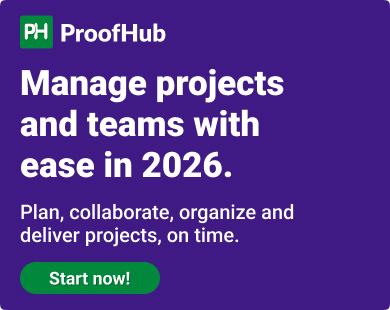Job interviews for Agile project management roles can be very stressful, especially when competition is high, expectations are more, and you are supposed to show knowledge as well as the mindset that makes Agile successful.
If you have ever walked out of an interview wondering, “I knew the answer, but just couldn’t quite explain it clearly,” you are not alone. Many candidates come up short convincingly describing their Agile expertise to an interviewer.
Good performance in an interview is necessary to get the job. But here is the challenge – Agile is not only about definitions; it’s about how you apply principles in real-life situations. The interviewer doesn’t want to know if you know Scrum or Kanban, but rather, how you used them to solve a problem, how you interacted with the team, and how you managed change.
Over the years, I’ve crossed paths with dozens of Agile experts – hiring managers, experienced project managers, and aspiring candidates. One thing that stands out is that those who succeed in Agile interviews don’t just memorize concepts. They know how to talk about their experiences. They highlight challenges they’ve faced, decisions they’ve made, and lessons they’ve learned along the way.
This is exactly what this article will help you with. Be you a fresher interviewee or an Agile expert looking to upgrade, the following 25 Agile project management interview questions will help you feel more confident while answering and thereby give you that desired impression at your next interview.
Let’s dive in to make sure that next interview gets you the job you deserve.
General Agile project management interview questions
When preparing for an interview for an Agile project management role, you can expect some general questions. These questions test your understanding of Agile principles and methodologies.
The interviewer also determines how well you understand the basics, your ability to apply Agile in real-world scenarios, and whether your mindset is in line with Agile values.
Here are a few common interview questions for Agile project managers and how you can approach them.
1. What is Agile project management?
The interviewer wants to know if you are familiar with Agile or not. You are expected to explain it as an approach where adaptability, teamwork, and continuous improvement come first. The interviewer may also want you to mention some Agile frameworks.
So, make your answer short and simple. Mention that Agile delivers work in small increments, not all together. You may also refer to some of the most widely known Agile frameworks like Scrum or Kanban.
Example: Agile project management is the flexible and collaborative approach through which teams can deliver projects in small, manageable parts rather than delivering everything at one time. Agile emphasizes teamwork, continuous feedback, and the need to respond quickly to changes.
Agile is widely used in software development, but it applies to any industry. The most popular Agile frameworks include Scrum, Kanban, and SAFe, all of which offer different approaches for the efficient management of projects.
2. What are the core values of Agile?
This question will enable the interviewer to determine whether you are aware of the Agile Manifesto, which defines the four core values that guide Agile methodologies.
Although you don’t have to commit them to memory, you should be aware of their main ideas. Give a brief explanation of the four Agile values, emphasizing their effects on project work.
Example: Agile is based on four core values from the Agile Manifesto –
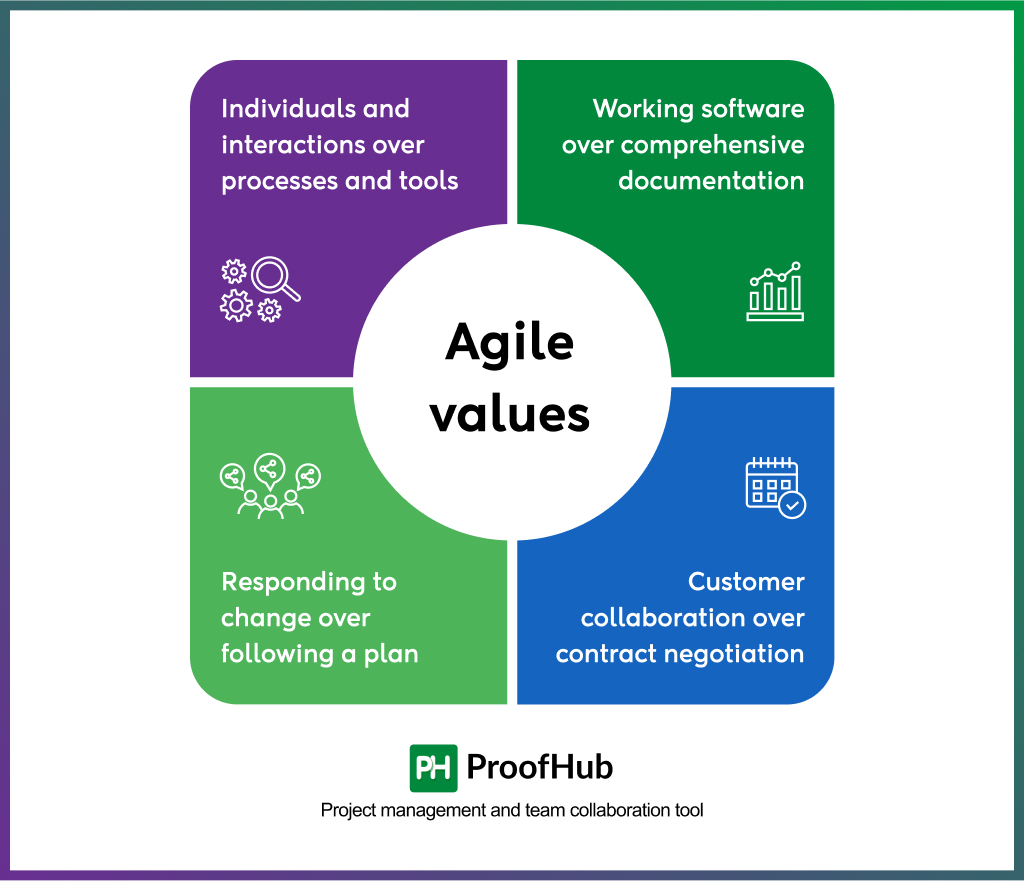
Agile core values
- Individuals and interactions over processes and tools: Strict procedures and equipment are less important than people and teamwork.
- Working software over comprehensive documentation: Producing copious documentation is not as important as delivering a functional product.
- Customer collaboration over contract negotiation: Working together with customers is more beneficial than simply adhering to a contract.
- Responding to change over following a plan: Being able to adjust to change is preferable than following a fixed plan.
These values allow teams to be agile, oriented around delivering value to the customer, and responsive to needs.
3. How does Agile differ from traditional project management?
Highlight the key difference between Agile and the traditional, or Waterfall model, of project management. Explain how Agile allows for flexibility, continuous feedback, and progressive delivery.
Compare Agile and traditional project management in a non-techie manner. Mention differences related to planning, customer involvement, and even the delivery approach itself.
Example: Flexibility is the main difference between Agile and traditional project management. Waterfall, for instance, is a traditional approach that follows a step-by-step process where everything is planned out and changes are hard to be made.
Agile, however, accepts change and lets teams make adjustments in the course of executing their plans. Agile is also keen on continuous customer feedback compared to the traditional approach that focuses more on fixed contracts and requirements. The delivery of a project is not given all at once; instead, Agile breaks down projects into smaller tasks and delivers value throughout the process.
4. What are some popular Agile frameworks?
Be aware of different ways Agile can be implemented. You don’t need to be an expert in all of them, but you should be able to name a few and explain them briefly.
Mention at least three to five popular Agile frameworks and explain each one in a sentence or two.
Example: Agile has several frameworks that teams can use based on their needs –
- Scrum: A structured approach with defined roles (like Scrum Master and Product Owner) and time-boxed work cycles called sprints.
- Kanban: A visual system that helps teams manage workflow using boards with columns like ‘To Do,’ ‘In Progress,’ and ‘Done.’
- SAFe (Scaled Agile Framework): Designed for large organizations that need to coordinate multiple Agile teams.
- Lean: Focuses on eliminating waste and optimizing efficiency.
- Extreme Programming (XP): A software development method that emphasizes coding best practices and frequent releases.
5. How do you measure success in an Agile project?
You measure success differently in Agile projects than in traditional projects. Here, you succeed based on continuous improvement, customer satisfaction, and team productivity.
Mention a few typical Agile metrics. State why they are important and what they do. Keep this as simple and practical as possible.
Example: In Agile, it is not just about delivering a project on time but also about giving value to the customer, adapting to changes, and continuously improving the process.
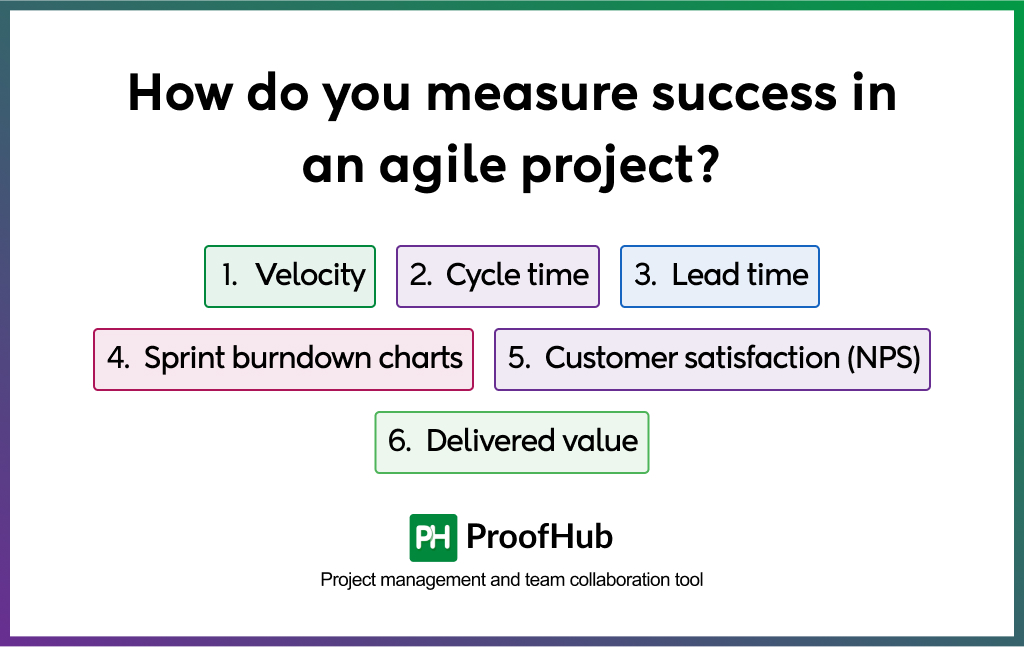
Here are a few key performance indicators to measure success in Agile:
- Velocity: Measures the amount of work a team accomplishes in a sprint.
- Cycle time: Refers to how long it takes to finish the task from beginning to end.
- Lead time: Shows the time from request to delivery.
- Sprint burndown charts: Help teams monitor progress during a sprint.
- Customer satisfaction (NPS): How happy customers are with the product.
- Delivered value: Whether the project meets customer needs and business goals.
Experience and background-based questions
Experience-based questions allow interviewers to ascertain your proficiency with Agile methodologies in practice. They would like to understand whether you have ever applied Agile principles to resolve issues, manage teams, and deliver results.
Here are a few common questions you may come across, along with some guidance on how best to answer them.
6. Can you describe an Agile project you’ve worked on?
This is your chance to show your experience. Pick any project that best illustrates your skills and knowledge of Agile practices.
Start with explaining the problem or goal that the project was trying to achieve. Next, describe the Agile method you used—maybe it was Scrum, Kanban, or another.
Also, mention the problems that occurred in the project and how you fixed them. Finally, share the results—did the project succeed? What, if anything, did you learn from the experience?
7. What role did you play in your last Agile project?
Be specific about what your role was. Were you the Scrum Master, Product Owner, or Agile Project Manager? Describe what your responsibilities were and how you contributed to team success.
As an example, if you were the Scrum Master, you can talk about how you ran the daily stand-ups, removed obstructions for the team, or helped with process improvement in the retrospectives.
8. Have you ever managed a remote Agile team? How did you handle it?
Remote work is becoming more common, and managing a remote Agile team comes with its own set of challenges. If you’ve had some experience in this area, consider the tools you found most effective – like ProofHub for team collaboration and managing tasks or Zoom for facilitating your meetings.
Share how you kept things in sync across your team, maybe with regular stand-ups or regular check-ins. If you have used any unique strategies, like asynchronous communication or virtual retrospectives, make sure you mention those too.
9. Have you worked with SAFe, LeSS, or Nexus?
If you have experience with Scaled Agile Framework (SAFe), Large-Scale Scrum (LeSS), or Nexus, let your interviewee know how you used the framework in your project.
For instance, if you have experience with SAFe, you can talk about how you managed multiple teams or coordinated dependencies among them.
If you do not have experience with these frameworks, that is fine too! Just be honest and let them know that you are willing to learn and adapt to various Agile scaling approaches.
In-depth Agile project management questions
Advanced Agile project manager interview questions evaluate your expertise in Agile principles, processes, and leadership competencies. These questions test your skills to handle real-world Agile situations.
Below are some common in-depth questions and their answers.
10. What are the key Scrum ceremonies?
Scrum ceremonies are periodic team meetings that ensure everyone stays aligned and on track.
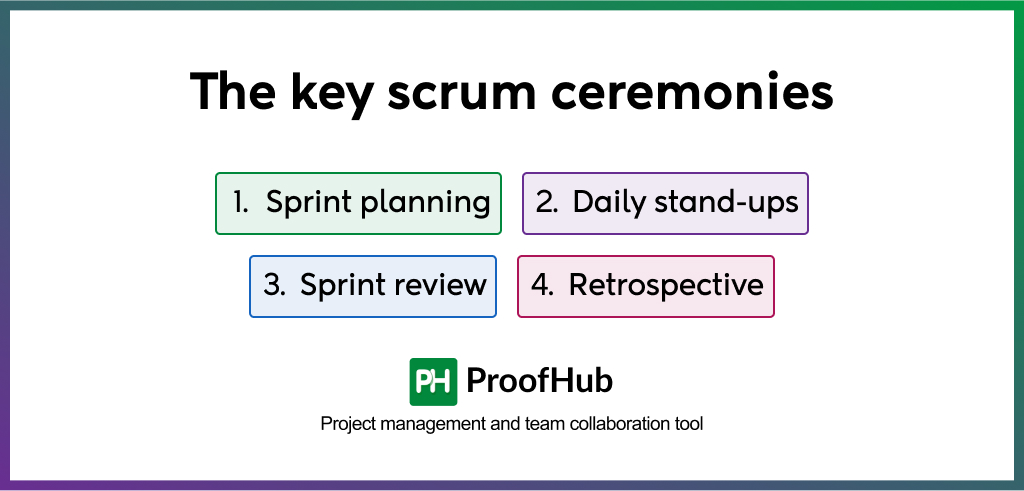
The key ones are:
- Sprint planning: At the beginning of every sprint (short work period, typically 2-4 weeks), the team plans what work they will be doing. They select work from the backlog (list of work to be completed) and decide how to work on them.
- Daily stand-ups: Short 15-minute meetings where everyone discusses what they did yesterday, what they will be doing today, and whether they have any issues.
- Sprint review: At the end of the sprint, the team presents what they’ve done to project stakeholders (those interested in the project). It’s an opportunity to get feedback and bask in the success.
- Retrospective: After the review, the team reflects on what worked, what didn’t, and how they can do better in the next sprint. It’s more of a team “lessons learned” session.
11. How do you handle a constantly changing backlog?
A backlog is a list of work or features to be completed. It’s expected to change as priorities shift. Here’s my strategy to handle it:
- Regularly review and update the backlog so it is organized and to the point.
- Use prioritization techniques like MoSCoW (Must have, Should have, Could have, Won’t have) or WSJF (Weighted Shortest Job First) to figure out what’s most important.
- Talk with stakeholders regularly to understand their needs and explain how changes will affect the timeline or goals.
12. What’s the difference between Scrum and Kanban?
Scrum and Kanban are both Agile approaches, but they work differently:
- Scrum: This method structures work into time-boxed sprints (typically 2-4 weeks). During each sprint, the team focuses on completing a defined set of tasks.
- Kanban: No time-boxed sprints. Kanban is a flow-based system. The team works on tasks continuously while having work-in-progress (WIP) limits to prevent overloading.
13. What is the Definition of Done (DoD) in Agile?
The Definition of Done (DoD) is an explicit list of things that must be completed before a task, feature, or project is considered done. For example, it can include requirements like “the code is tested,” “documentation is up to date,” and “stakeholders have signed off.” This way, everyone’s on the same page and is clear about what “done” is.
14. What are Agile artifacts in Scrum?
In the world of Scrum, Agile artifacts serve as invaluable tools or documents that assist a manager in monitoring progress and fostering transparency. Among these are:
- Product backlog: A comprehensive list of all the tasks and features required for the product’s completion.
- Sprint backlog: A detailed list of specific tasks that must be accomplished during the current sprint.
- Increment: The sum of all the work completed within a sprint, which should be ready to use or deliver.
15. Explain the concept of technical debt in Agile
Technical debt is similar to time borrowing. When developers cut corners to speed up their work (be it by bypassing tests or coding badly), they later owe time to pay back those debts.
If they don’t pay back that debt, it could make them slow later. In Agile frameworks, the trick is to strike a balance between speed and quality so that you don’t accumulate too much debt.
16. What’s your experience with test automation in Agile?
Test automation is using tools to test whether the software is functioning properly. In Agile, it is useful because it is time-saving and identifies issues early.
For instance, rather than testing each feature manually after a modification, automated tests can perform it efficiently. This allows the team to work on creating new things rather than fixing old things.
17. What are the most important Agile KPIs?
Key performance indicators, or KPIs, are metrics for measuring the efficiency of the team. Some of the most important KPIs of Agile are as following:
- Velocity: The quantity of work completed within a sprint. It predicts subsequent performance.
- Cycle time: Duration to complete a task from beginning to end. Shorter cycle times mean quicker delivery.
- Burndown chart: A visual representation of remaining work in a sprint. It keeps the team on track.
- Customer satisfaction: User or stakeholder feedback to ascertain if the product is compatible with their requirements.
Leadership and team management questions
With Agile management, your ability to lead and manage a team is just as valuable as your agile project management skills.
The following questions will help interviewers gauge how competent you are at team leading, problem-solving, and achieving harmony among all team members.
18. How do you handle conflicts within an Agile team?
Conflict is a natural part of working together, but it is how you resolve it that counts. Consider how you might listen intently to what each person has to say, figure out where the problem originates, and assist the team in finding a solution.
You can also include techniques such as active listening (actually listening to what others say), mediation (assisting people to communicate with one another), and ensuring that everyone feels at ease sharing their thoughts.
Read more: What is conflict management?
19. What’s your approach to cross-functional teams in Agile?
Cross-functional teams consist of individuals with various skills who collaborate toward a single objective. Describe how you would motivate teamwork, ensure that each member is aware of their contribution, and eliminate any roadblocks between the members. The goal is to develop a culture where everyone is responsible for the success of the project.
20. What do you do if stakeholders demand scope changes mid-sprint?
Changes can happen, but they need to be handled with care. Share how you’d talk to stakeholders about the impact of the change, weigh the benefits, and consider whether it is worth a change to the sprint.
If the project scope change is inevitable, you can negotiate changes or delay the request to the next sprint while keeping the team committed to the original plan.
21. How do you handle missed sprint goals?
Missing a goal is not failure, it’s an opportunity to learn from your errors. In this question, explain how you’d determine why the goal was missed, reallocate the workload of the team if required, and work on doing better in the next sprint.
22. How do you manage dependencies across Agile teams?
When teams rely on each other, transparency, coordination, and effective communication are essential. Explain how you would make sure that everyone is aligned, plan ahead to avoid delays, and have all teams synchronized in their work.
Regular sync meetings, shared backlogs, and dependency mapping can keep everything in alignment and avoid bottlenecks.
Product owner and business agility questions
A strong Agile team relies on a great Product Owner to make sure that the product not only meets customer needs but also stays focused on business goals.
Below questions assess your ability to prioritize, deliver value, and align with customer needs.
23. What makes a great Agile Product Owner?
Several exceptional attributes define a great Product Owner including a deep customer needs knowledge base along with strong teamwork abilities. They communicate clearly, so everyone, from developers to stakeholders, stays on the same page.
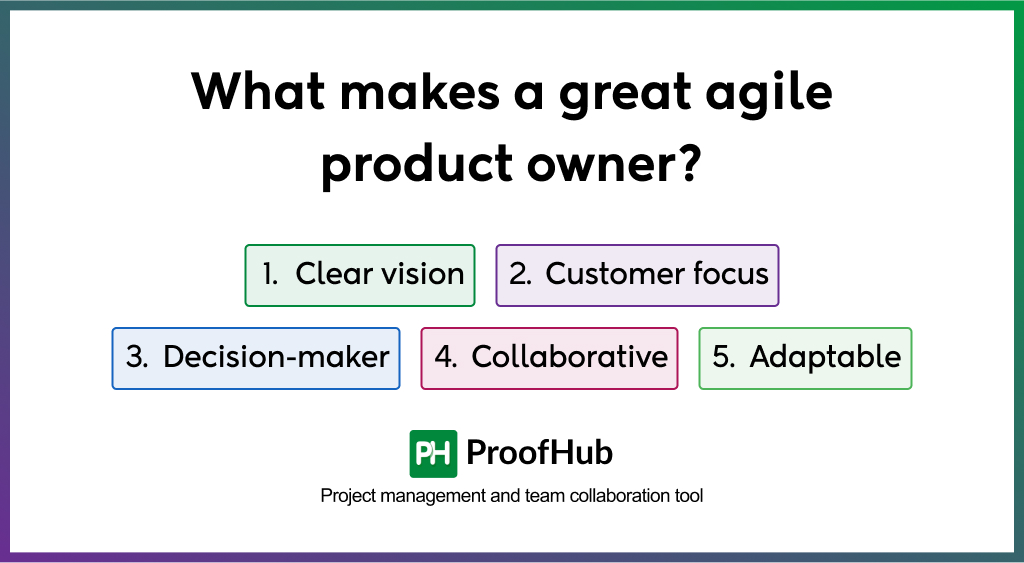
A great Product Owner displays these essential qualities which distinguish them from others:
- Clear vision: They understand product requirements completely; thus, they can describe goals within basic terms.
- Customer focus: They always think about what the customer needs and how the product can solve their problems.
- Decision-maker: They possess the ability to handle critical decisions swiftly concerning selecting which features to start developing early on.
- Collaborative: They work well with the team, listen to ideas, and provide feedback.
- Adaptable: They’re open to change and can adjust plans when new information comes up.
24. How do you prioritize a product backlog?
Prioritizing a product backlog means deciding what tasks or features are most important. A product owner needs to balance customer requirements with business objectives and team readiness to start with the most valuable features.
Some common methods to help product backlog prioritization are as follows:
- Value to the customer: The Product Owner should concentrate on features that offer maximum customer benefits. Any feature that eliminates major problems or significantly enhances user experience should get priority position in the list.
- Effort vs. Impact: Analyzing work requirements alongside delivered benefits determines decision-making processes. If something is quick to do but has a big impact, it’s a good candidate for early delivery.
- Dependencies: Some tasks need to be done before others. For example, you can’t build a roof without first building the walls.
- Feedback: Use input from customers and stakeholders to guide priorities.
25. What’s the difference between MVP and MMP?
- MVP (Minimum Viable Product): The most basic form of a product that can be launched in order to test an idea. It contains only the bare minimum features necessary to check if the customers find it useful.
For instance, if one is developing an app, it might have a single core feature to test if people like the concept.
- MMP (Minimum Marketable Product): This is the smallest version of a product that can actually be sold or marketed to customers. It has just enough features that make it useful and attractive.
Using the same example, MMP includes several extra features that make the app functional and attractive enough to encourage people to buy or use it repeatedly.
Final thoughts
A role in Agile project management demands a mix of understanding of Agile principles and practical skills along with technical experience.
Whether you’re an experienced professional or new to the Agile industry, the above-mentioned Agile project management interview questions can help you prepare and show your knowledge.
Once you land your dream job, having the right project management software, such as ProofHub, will help you manage your projects and tasks effectively.
ProofHub is a comprehensive project management and team collaboration tool that works smoothly with Agile methodology. It offers features like task management, time tracking, Kanban boards, Gantt charts, discussions, online proofing, and more, allowing you to stay organized, meet deadlines, and achieve outstanding results – all in one place. It’s a great choice for any Agile project manager looking to streamline workflows and keep projects on track.
We wish you the best in your interview and your Agile career. With the right preparation, skills, and tools, you’re well on your way to success.
All the best!

